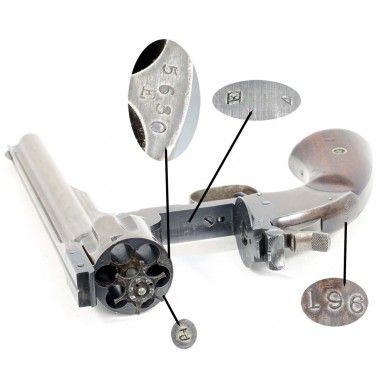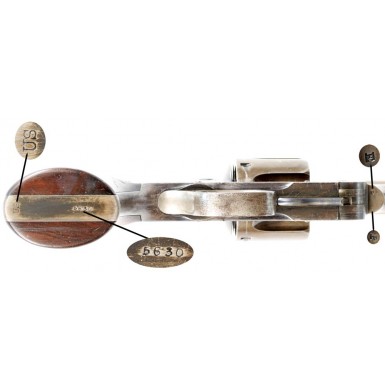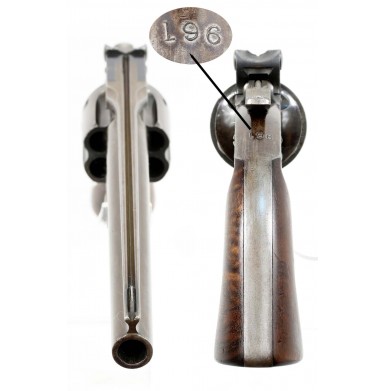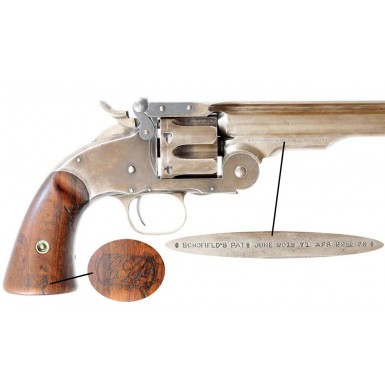2nd Model Schofield - San Francisco PD Marked!
- Product Code: FHG-1961-SOLD
- Availability: Out Of Stock
-
$1.00
In 1870, the US Army purchased its first large lot of self-contained cartridge handguns. The purchase included 1,000 Remington rolling block single shot pistols chambered in .45-25, 1,000 Remington New Model Army .44 caliber revolvers altered to metallic cartridge and 1,000 Smith & Wesson #3 “American” revolvers in .44 S&W. While both officers and the rank and file had been requesting cartridge revolvers from the Ordnance Department since the end of the American Civil War, two large stumbling blocks had prevented the Army from abandoning the .44 caliber percussion revolver. The first was the fact that the Rollin White patent for the bored through cylinder, which was controlled by Smith & Wesson, would not expire until 1869. The Ordnance Department understood that no other manufacturer could produce a successful metallic cartridge revolver design until that patent expired. Secondly, the Army had a massive inventory of percussion revolvers that were now becoming obsolete and were of limited value for sale on the commercial market. As a result, the army continued to use its percussion revolvers well into the mid-1870s. The three types of cartridge handguns purchased all had their various supporters and detractors. The rolling block pistol was strong, simple and durable, but only offered a single shot. The altered Remington revolvers functioned suitably, but were still considered “make do” conversions of obsolete guns. The new Smith & Wesson design was modern and offered rapid unloading and extraction due to its top break design, and offered equally quick reloading. The downside to the Smith & Wesson was that it was somewhat delicate, with numerous small parts that were prone to breakage, and it was questioned whether it could stand up to the rigors of duty on the western frontier. One army officer who was particularly impressed by the Smith & Wesson design was Major George W. Schofield of the 10th US Cavalry, one of the famous African-American regiments of “Buffalo Soldiers”. Schofield was so impressed with the design that he arranged to act as a sales agent for Smith & Wesson. Schofield sold more than one hundred Smith & Wesson #3 American revolvers between the fall of 1870 and spring of 1871. Most of those guns were almost certainly sold to other cavalry officers, and as a result Schofield started to build a foundation of support for the Smith & Wesson design. Schofield did note that there could be improvements made in the #3 design, and went to work to modify the revolver to be more cavalry friendly. The most striking improvement was to redesign the latch that closed the top break frame. The original #3 design had the latch mounted in the top strap of the revolver and requited the user to hold the gun with one hand and lift the latch with the other hand to break the gun open. This was awkward at best on horseback, and even more difficult if the horse was moving any faster than a walk. Schofield’s improvement relocated the latch to the frame of the revolver and redesigned the catch so that the thumb of the right hand could depress it while the pistol was being held in a conventional grip. The top of the barrel of the pistol could then be pushed against the trooper’s leg or saddle, opening the action and ejecting the empty cartridges. This allowed one handed opening and ejection and made the gun much easier to use on horseback. Schofield also modified the ejection system, and received patents for his improvements; in June of 1871 for the latch and April of 1873 for the ejection system. With these ergonomic and functional improvements to the revolver, Schofield proceeded to arrange for US Ordnance Department trials of the new pistol. However, Schofield was a little late. In November and December of 1872 additional trials had taken place between several models of Smith & Wesson and Colt revolvers. The winning design was the Colt, a gun that would become the most famous and recognizable handgun of the old west era, the Model 1873 Single Action Army, aka “Peacemaker”. The Colt design was found to be more durable, simpler, stronger, more accurate and to contain significantly fewer parts, when compared to the Smith & Wesson submissions. After the favorable testing, Colt received an order to deliver 8,000 revolvers chambered for the new .45 Colt cartridge, the cartridge found most desirable by the Ordnance Department after testing numerous cartridge designs between 1872 and 1873. Schofield should have accepted defeat at this point, but he had quite a bit of political pull within the army. His brother was General John Schofield of Civil War fame, and the General was a friend of General William Tecumseh Sherman, who served as General of the Army (five star general, commanding all US land forces) from 1869-1883. General Schofield had also served briefly as the Acting Secretary of War (June 1868-March 1869), had been in command of the Military Division of the Pacific and in 1876 would be made the Superintendent of The US Military Academy at West Point. Between Major Schofield’s inroads with officers who supported the Smith & Wesson design and the political influence of his brother, he managed to get his redesigned Smith & Wesson revolver in front of the Board of Ordnance for review in June of 1874. The findings were sufficiently positive that a contract was let to Smith & Wesson for 3,000 of the new “Schofield” model revolvers in September of 1874. These guns would become known to collectors as 1st Model Schofield revolvers. They were six-shot, single-action revolvers with 7” ribbed barrels, a square butt profile and two-piece walnut grips. While most were blued with color case hardened triggerguards and hammers, some were delivered in nickel. These .45 caliber revolvers were chambered for the .45 S&W (aka “.45 Schofield”) cartridge. The action of the revolver could not function with the standard .45 Colt cartridge then in use. The Colt cartridge was too long for the Smith & Wesson cylinder, and the rim of the Colt cartridge was too small to be effectively engaged by the star extractor of the Smith & Wesson, which meant that the Colt cases would fall through the extractor become stuck in the cylinder chambers. The .45 S&W cartridge was about .10” shorter than the .45 Colt, with a larger rim, and slightly smaller powder charge and lighter bullet. The Smith & Wesson cartridge could usually be used in the Colt revolvers, but the Colt cartridge could not be used in the Smith & Wesson guns. Initial reports from the field were positive enough that a second contract was let to Smith & Wesson for 3,000 more revolvers in March of 1875. These would become known to collectors as the 2nd Model Schofield. In all, a total of 5,285 2nd Model Schofields were delivered to the US Army between 1876 and 1877, with a total production of 5,934. In most respects the guns were identical to the preceding “1st Model”, with the most noticeable improvement being the dishing out of the barrel catch to make it easier to put your thumb into it and open the action. This also changed the profile of the catch itself and the rear sight that was built into the catch. The other major change cannot be seen, but the frames of the 2nd Model Schofield revolvers were made of steel instead of iron. Major Schofield received a $.50 per unit royalty payment for design improvements for every 2nd Model that was sold, but did not receive any royalty payments for the 1st Model revolvers. The Schofield revolvers were issued throughout the US cavalry to get good side-by-side comparisons of their effectiveness and durability when compared to the Colt M-1873. The guns saw significant service with the 4th US Cavalry, as well as with the 9th & 10th US Cavalry (the Buffalo Soldiers). However, it was not long before the original complaints about the Smith & Wesson #3 in terms of fragility and mechanical issued began to rear their ugly heads again. However, the ammunition for the guns caused an even bigger problem. The intentional issue of the Colt and Smith & Wesson revolvers to the same regiments resulted in ammunition snafus. In an attempt to circumvent this issue, Frankford Arsenal developed a universal cartridge for use in both revolvers. It was shorter and lower powered than the .45 Colt and had a slightly larger rim to help with extraction from the Smith & Wesson. However, it was not uncommon for .45 Colt ammunition to be issued to troops with Schofield revolvers, who could not use it. Likewise, the .45 S&W ammo had such a large rim that it often prevented all the chambers from being loaded in a Colt revolver, or could even cause the Colt cylinder to bind up. Despite the significant advantage in unloading and loading speed that the Schofield offered, the numerous small issues with the mechanism and the ammunition difficulties resulted in the gradual removal of the Smith & Wesson revolvers from US military service. This is somewhat ironic, as during the decade from 1873 to 1882, Smith & Wesson would produce about twice as many of their large frame single action revolvers (mostly the various #3 models) than Colt would produce Single Action Army revolvers. Smith & Wesson found their success with the civilian market and with foreign military contracts, while Colt continued to find the US government their most lucrative customer. During the 1880s, the US military began divesting themselves of both 1st & 2nd Model Schofield revolvers. The guns were primarily sold to Schuyler, Hartley & Graham and Francis Bannerman & Company, both of New York. Many of these guns were subsequently altered by having their 7” barrels cut down to 5”, and often the guns were nickel-plated. The single largest customer for these altered Schofield revolvers was the Wells Fargo Express Company, who marked the guns W.F. & Co. Ex. when they purchased them. However, some Schofield revolvers remained in service right up to the era of the Spanish American War, and some are noted by serial number in the Springfield Research Service series of serial number books as being in used during the mid to late 1890s, mostly with state militias and guard units. This is supported by the fact that as late 1890, Frankford Arsenal was still loading the universal .45 caliber Colt/S&W cartridge. As the large majority of military contract Schofields were sold as surplus and altered during the 1880s and 1890s, it is difficult to find them in fine original condition and in their original configuration. Much like the 7 ““ Single Action Army “cavalry” revolvers that were mostly altered to mixed number, 5 ““ “artillery” configuration, original cavalry Schofields are scarce and extremely desirable.
Another interesting chapter in the story of the Smith & Wesson Schofield occurred in the San Francisco area during 1877 and 1878. In 1873, an economic depression had afflicted most of Europe and had migrated to American shores. While the combination of factors creating the crisis were multidimensional, one that directly affected the American West was the Coinage Act of 1873, the decision to move from a gold-silver monetary system to the gold standard. This ended the minting of silver coins in America, which had a disastrous effect on the silver mines of the west, as the value of silver plummeted with the government no longer buying it for use in coins. Additionally, the economic collapse had started in the major cities of the east, primarily New York, Boston and Chicago, and the lack of jobs and economic opportunity had caused many Americans to move west. The pressures placed on western US economies by the precipitous drop in silver value and the increased population resulted in widespread unemployment, particularly in urban centers like San Francisco. The end result was that thousands of unemployed and disenchanted people struggling to survive and in search of hope. Many found a hopeful message with the Workingman’s Party of the United States, a socialist labor movement. On July 23, 1877, some 8,000 members and interested parties gathered near the San Francisco City Hall for a “meeting”, which by the end of the night had devolved into a massive riot that lasted well into the next day. One of the points of tension, and a classic cry of those who would incite violence during hard economic times, was that the problem was the “foreigners”. Little thought was given to the fact that nearly all of those who gathered for this meeting were immigrants themselves who had only been in the United States for one or two generations. The chosen scapegoat were the Chinese laborers, whose massive influx over the last decade had resulted in lower wages and fewer job opportunities for newly arrived easterners. The cry of “Chinamen must go!” echoed through the night and would become the rallying cry for the Workingman’s Party, which would be the genesis of the Socialist Labor Party of America. The riots eventually petered out after heroic efforts by San Francisco Police, supported by the state militia which was called out as well. Soon thereafter a group of concerned citizens known somewhat derisively as the “Pick Axe Brigade” was formed to assist with the suppression of the violence and to discourage further rioting. However, it would take more than a year before the constant threat of possible riots would pass, and much longer before the racial tension would moderate. During this time, the San Francisco Police determined that they were woefully ill-prepared and under equipped to deal with such mass civil unrest. To that end some three hundred US army Schofield revolvers (both first and second models) were issued to the San Francisco Police Force during 1877 and 1878. According to research by Charles Pate (see his Man At Arms article on the subject), the guns were issued from the Benicia Arsenal (about 35 miles north-east of San Francisco). Since 1851, Benicia had been the primary US arsenal on the west coast and would remain so through the mid-1960s. According to Pate’s research, all the revolvers issued to the SFPD from the Arsenal were stamped with large, individual inventory numbers on the backstrap, behind the hammer. Although there are records of the guns being issued, there is no evidence that they were ever returned it seems likely that since the guns were already falling out of favor and most were soon to be sold off as surplus, that the US Army simply did not put any effort into retrieving the three hundred revolvers. The guns no doubt remained in service with the SFPD until they were obsolete, and likely replaced with double action .38 caliber revolvers around the turn-of-the-century. Today, they remain an interesting footnote in the story of the Smith & Wesson Schofield revolver, and make a particularly scarce and desirable variation for the advanced Smith & Wesson collector.
Offered here is a VERY GOOD+ example of a San Francisco Police Department Smith & Wesson 2nd Model Schofield cavalry revolver. The gun is 100% complete and correct in every way and is a very nice, unaltered example of a scarce US military revolver from the height of the Indian War era, that subsequently saw police service with the same police department that gave us the iconic “Dirty Harry” Callahan movie character. The revolver is serial number 5630, and that number is clearly stamped in the butt of the revolver, along with the ownership mark US. The serial number is also clearly stamped on the rear face of the cylinder and inside the right grip panel. The San Francisco Police Department inventory number 196 is stamped on the top of the backstrap, behind the hammer. The inspector initials E and P are crisply stamped in the bottom of the barrel web, with the same inspector initials on the rear face of the cylinder, and the initial E on inside top of the bottom of the frame. The left side of the ejector housing is clearly roll stamped in two lines, with a Maltese Cross at each end of the legend:
SMITH & WESSON SPRINGFIELD MASS. U.S.A. PAT. JAN. 17TH
& 24TH 63. JULY 11TH 65. AUG 24TH 69. JULY 25TH 71.
The right side of the ejector housing is marked in a single line:
SCHOFIELD’s PAT. APR. 22D 1873
This line is also flanked by a pair of Maltese Crosses. The grips both bear very nice cartouches. The right grip has a crisp and clear script CW cartouche for US arsenal sub-inspector Charles Woodman. The left grip has an equally fine script JRJr., for US Ordnance Department inspector Lt. James Rockwell Jr., over the acceptance date 1876. This gun would have been about in the middle of the production for the second Schofield contract from March of 1875. The pistol is really in about VERY GOOD+ condition. The frame retains about 5%-10% of what appears to be the original factory blue, which shows significant fading, thinning and loss. The barrel retains only the most minor traces of blue around the forcing cone and in the recesses of the barrel rib. The balance of the barrel has a slightly mottled grayish-brown patina, with some lightly scattered areas of minor surface oxidation and some very lightly scattered pinpricking. This odd grayish-brown patina with bluish tones is fairly common on the barrels of Schofields that retain minimal finish. The areas of the frame that show major finish loss, particularly the gripstrap and backstrap, have a very nice grayish brown patina similar to the barrel, with streaky traces of blue present. As noted, the barrel shows some lightly scattered areas of minor surface oxidation, and some pinpricking forward of the cylinder and at the muzzle. The frame remains mostly smooth with only some very lightly scattered flecks of surface oxidation and a few tiny areas of very minor pinpricking. The bore of the revolver is in about FINE condition overall, and remains mostly bright with crisp rifling. The bore shows some very lightly scattered pinpricking and frosting, but appears free of any real pitting. The cylinder retains some traces of original blue as well, mostly in the cylinder flutes, with the balance having a grayish-brown patina that matches the barrel of the revolver well. The chambers remain smooth and bright and are in fine condition as well. The hammer retains some traces of case coloring, having faded and dulled significantly with age. The hammer spur retains excellent, sharp checkering. The triggerguard retains about only traces of case coloring and has a mostly dusky bluish-gray patina. There is still some vibrant coloring present on the web at the front and rear of the triggerguard. The trigger retains about 50%+ of its original niter blue, having faded and dulled, with some silvering on the edges and contact points. The screws all retain some traces of their pale niter blued finish, but have dulled and faded. All the screw heads are in good condition, with some showing light to moderate slight wear, and balance appearing quite crisp and relatively untouched. The revolver is mechanically FINE and functions perfectly. The pistol indexes, times and locks up perfectly, and the extraction system functions smoothly and correctly. The revolver locks up tightly and the frame to barrel fit is excellent with no wobble or looseness. The two-piece walnut grips are in FINE condition and remain quite crisp and well-marked. They both are solid and complete with no breaks or repairs. The grips show some minor rounding to the sharp leading and trailing edges of their bottoms. There is some minor surface cracking on the interior of the left grip panel where the grip screw was over-tightened causing strain on the escutcheon which caused some minor surface cracking inside the grip. This is solid and stable and only inside so it is completely invisible. As noted the right grip panel is correctly stamp-numbered to the revolver on its interior and both grips retain very crisp, clear cartouches and the left grip shows an excellent 1876 acceptance date. The grips do show some light bumps and dings from handling, use and storage, but are in truly great condition.
Overall this is very nice example of a scarce US martial handgun from the Indian War era that also has San Francisco Police history. This Smith & Wesson 2nd Model Schofield is 100% complete and correct in every way. The revolver was delivered in 1876, the same year that Brevet General George Armstrong Custer led his 7th Cavalry to their death along the banks of the Little Big Horn River. 2nd Model Schofields are rather scarce, with only 5,285 delivered on contract to the military between 1876 and 1877. By contrast, some 37,000 US M-1873 Single Action Army revolvers were accepted for US military service between 1873 and 1892; about seven times as many! With so many of the Schofields being sold as surplus, and subsequently having their barrels shortened and often receiving new nickel finishes, it is rather difficult to find an all original, un-altered Schofield for sale. In some cases, the Schofield revolvers escaped the gunsmiths at Bannerman’s and Schuyler, Hartley & Graham by being issued to a state militia regiment during the 1880s. This one escaped by fighting socialist rioters in San Francisco, and helping to fight the oppression of Chinese immigrants. Overall, this is a very nice example of a US cavalry revolver, accepted in the most infamous year of the Indian War period, and a gun that would be equally at home in a collection that was dedicated to the arms used by lawmen and police in the Old West. Don’t miss your chance to add a very nice piece of US military, Indian War and San Francisco Police history to your collection.
SOLD







